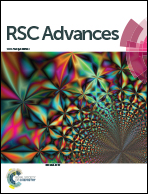A facile approach to silica-modified polysulfone microfiltration membranes for oil-in-water emulsion separation†
Abstract
A versatile strategy to fabricate newly-developed silica-modified membranes based on organic/inorganic hybridization for oil/water separation is described in this study. The modified membranes are easily obtained by a simple two-step immersion of polysulfone hollow fiber membranes with radial gradient microstructure (RGM-PSF) into a silicon solution of tetraethyl orthosilicate (TEOS) mixed with 3-glycidyloxypropyltrimethoxysilane (GOPTS) and subsequently into a lactic acid solution. Attenuated total reflectance Fourier transform infrared spectroscopy (ATR-FTIR), X-ray photoelectron spectroscopy (XPS) and field emission scanning electron microscopy (FE-SEM) were utilized to characterize the surface compositions and microstructures. A micro/nano-scaled SiO2-based coating was generated roughly and continuously on the membrane surfaces, endowing them with superhydrophilicity and underwater superoleophobicity. Results of dead-end filtration experiments demonstrated that the hybridized RGM-PSF membranes could be applied in oil-in-water emulsion separation far more efficiently, with higher water permeate flux, better oil rejection ratio, and higher pressure endurance than those of the common ones. Therefore, this study has provided a facile approach to prepare silica-modified membranes with special wettability, showing prominent application prospects for oily wastewater treatment in practical processes.


 Please wait while we load your content...
Please wait while we load your content...